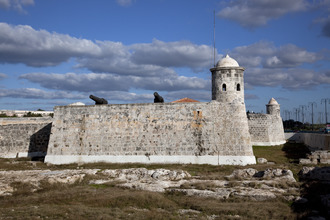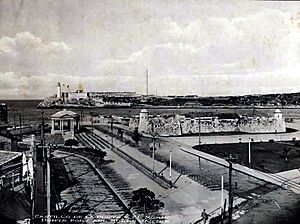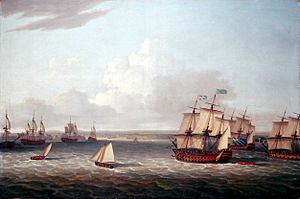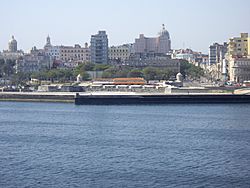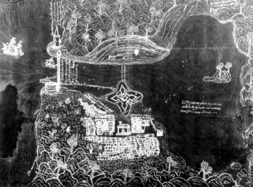Castillo San Salvador de la Punta facts for kids
The Castillo San Salvador de la Punta is a historic fortress. It stands at the entrance to the bay in Havana, Cuba. This strong building was made to protect the city from attacks.
History of the Fortress
The fortress, often called La Punta, was built to guard Havana's bay. It protected the city from frequent attacks by corsairs and pirates. In 1559, people first set up lookouts here.
In 1582, King Philip II of Spain decided to build stronger forts. He wanted a system of fortresses across America, with Havana as a key point. Juan de Tejeda became governor of Cuba in 1593. He was an expert in building forts. He brought Giovanni Battista Antonelli, an Italian engineer, to help.
Construction started around 1590. It was a slow process. In 1595, a hurricane damaged the fort. Its walls were too thin. They were rebuilt much stronger after that. By 1602, the fort was still not finished. The engineer decided to make it a smaller, strong tower. It could hold about 10 to 12 cannons. Over time, parts were removed, leaving just three strong sections called bastions.
To make the bay even safer, a heavy copper chain was added in 1630. This chain stretched across the water between La Punta and El Morro. Old drawings show this chain protecting the harbor entrance.
In 1762, the British attacked Cuba. All the fortresses suffered damage. La Punta's protective walls and bastions were destroyed. During this invasion, a new chain was used. It branched out in different directions. Heavy wooden beams held it in place. Its ends were tied to cannons at La Punta and El Morro. Some parts of this chain still exist today.
After the Spanish regained control, a new governor arrived. He fixed and made the fort system bigger. In the 1800s, more changes were made. Four flat areas were built to hold more cannons.
In 1851, the fort was used as a prison. Many prisoners were held there. Among them was Narciso López, an adventurer from Venezuela. He was executed at La Punta after a failed attempt to free Cuba. This event caused strong feelings in the United States.
Cuba's Defenses Against Attacks
For centuries, Colonial Cuba was often attacked. Buccaneers, pirates, and French corsairs wanted Spain's riches from the New World. To stop these raids, defenses were built across the island in the 1500s. In Havana, the Castillo de los Tres Reyes Magos del Morro was built. It aimed to scare off invaders like the English privateer Francis Drake. He sailed near Havana but did not land.
Havana's defenses were tested in 1628. A Dutch fleet, led by Piet Heyn, captured Spanish ships in the harbor. This showed that the city needed stronger protection. In 1662, the English pirate Christopher Myngs took over Santiago de Cuba for a short time. This was on the eastern side of the island. He hoped to open up trade with nearby Jamaica.
Later, in 1741, the British Royal Navy attacked Guantánamo Bay. This happened during the War of Jenkins' Ear with Spain. Admiral Edward Vernon led the attack. His 4,000 troops faced Spanish attacks and sickness. This forced them to leave and go back to British Jamaica. The British tried to attack Santiago de Cuba again in 1748. They were not successful. A small fight between British and Spanish ships also happened near Havana in 1748.
The Seven Years' War started in 1754. It spread across three continents. In 1762, the war reached the Spanish Caribbean. Spain was allied with France, which meant they fought against the British. A British force of five warships and 4,000 soldiers left Portsmouth. Their goal was to capture Cuba. They arrived on June 6. By August, they had surrounded Havana.
When Havana surrendered, Admiral George Keppel entered the city. He became the new governor. He took control of the western part of the island. The British arrival quickly opened up trade. Havana began trading with British colonies in North America and the Caribbean. This changed Cuban society quickly.
Havana became the third-largest city in the Americas. It grew a lot during this time. But the British rule was short. Sugar merchants in London worried about sugar prices. This led to talks with Spain about colonial lands. Less than a year after Havana was taken, the Peace of Paris was signed. This ended the Seven Years' War. Britain received Florida in exchange for Cuba. France suggested this to Spain. They warned that Spain might lose Mexico and South America to the British otherwise. In 1781, General Bernardo de Gálvez of Spanish Louisiana took back Florida for Spain. He had troops from Mexico, Puerto Rico, the Dominican Republic, and Cuba.
Restoration Work
In the late 1990s, the Office of the City Historian began a project. They wanted to restore the fort to its original look. This included bringing back original features and spaces. During archaeological digs, valuable items were found. These were put on display when the fort opened as a museum.
However, being so close to the sea caused problems. Bad weather and rust damaged the building quickly. After a few years, the fort had to close. It was no longer safe for its collections or visitors.
Gallery
See also
 In Spanish: Castillo de la Punta para niños
In Spanish: Castillo de la Punta para niños
- List of buildings in Havana
- La Cabaña
- Batería de la de la Reina
- Torreón de San Lázaro
- Santa Clara Battery
- Malecón, Havana


